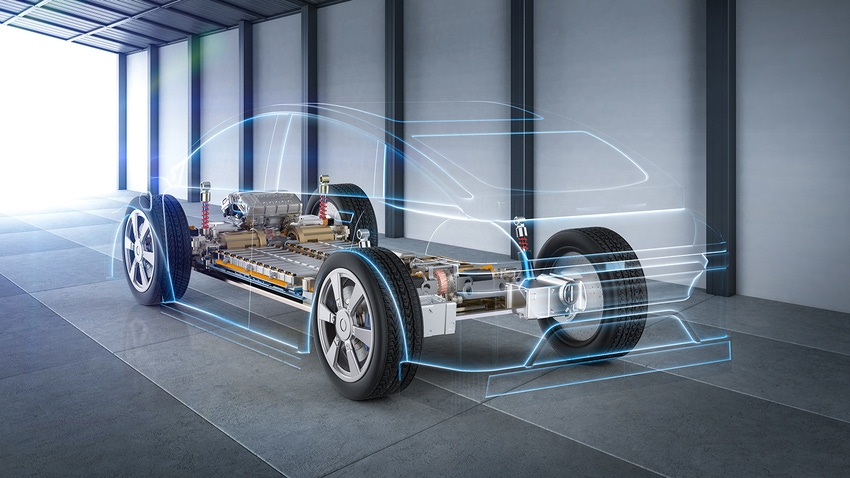Latex Binders in Sustainable Li-ion Battery Production
Why battery makers are investing in water-based processing for Li-ion battery cathodes in order to replace solvent and PFAS binder systems.

The electric vehicle (EV) market has experienced immense growth in recent years as more consumers transition away from combustion-engine automobiles. Because of this, and the need to adapt to evolving regulations, there is growing interest in advancing EV batteries to drive longer and charge faster by using technologies that work with water-based binder systems, such as emulsion polymer binders—also known as latex binders.
A small but essential part of EV batteries, latex binders play a critical role in enabling higher energy and power density. Latex binders are applied to the anode electrode in lithium-ion (Li-ion) batteries and compose less than 1% of the weight in the overall cell. However, not only does this small component serve as a processing agent in manufacturing, but it also helps maintain battery performance.
With the essential role anode binders play in batteries, companies are investing in extending and developing water-based processing for Li-ion battery cathodes in order to replace solvent- and per- and polyfluorinated substances (PFAS)-based binder systems.
Binder technology in Li-Ion batteries
Li-ion batteries have four main components: a positive electrode (cathode), a negative electrode (anode), a liquid electrolyte that helps ions move between the electrodes, and a separator to keep the electrodes from coming in direct contact with each other and prevent short-circuits and fires. The latex binder is an essential component in the anode electrode manufacturing process by connecting the graphite active material with conductive additives and binding them onto the anode current collector.
State-of-the-art binder technologies for commercial Li-ion batteries are water-based styrene butadiene latex (SBR) binders for graphite-based anodes and solvent-based polyvinylidene difluoride (PVDF) binder systems for the cathode. The binder system has three purposes in the Li-ion battery: First, it maintains mechanical stability upon battery cycling—ensuring adhesion to the current collector and cohesion between all anode electrode components while the graphite active material particles undergo a volume change of up to 10%. Second, the binder system must interact with the electrolyte solvents without being dissolved, so it needs to be chemically and electrochemically inert during the charge and discharge processes. Finally, it must also maintain polymeric structure and functionality within a large temperature window from -20°C during winter to more than 60°C, which are temperatures faced in summer or upon fast-charging processes.
These anode binders can be applied in low amounts, offering high adhesion and supporting electrochemical cell processes. By affecting electrode porosity and electrical and ionic conductivities, the binder system can enhance rate capabilities, low-temperature performance, and battery cycle life.
Water-based battery processes
Earlier this year, some European Union member states proposed legislation to the European Chemicals Agency to phase out PFAS in the EU due to their persistence as an environmental pollutant and negative impact on human health. A potential ban on the use of this family of chemicals would affect a plethora of products, including EV batteries, as the PVDF cathode binder system falls into the PFAS category.
Because of this growing support for banning PFAS, battery manufacturers are increasingly more interested in water-based processing of cathodes, as it can offer two significant benefits: It can replace PVDF as a cathode binder and hence also remove the need to use N-Methyl-2-pyrrolidone (NMP), which is the solvent for PVDF binders and a known potential hazard to human health. Removing PVDF creates a more sustainable cell manufacturing process and eliminates the need for NMP handling and recycling facilities, in turn benefiting CAPEX and OPEX procedures.
Recent studies have shown that water-based processing by applying latex binders can result in similar or even improved electrochemical performance compared to NMP-processed batteries, which use PVDF as a cathode binder. In fact, styrene acrylate (SA)- and polyacrylic acid (PAA)-based technologies might be considered more sustainable cathode binder systems to replace PFAS-based chemistries.
The future of Li-ion batteries
As the industry explores new ways to increase the mileage of EV batteries, as well as improve the fast-charging potential, silicon (Si) has become a leading material for these improvements. Si can be used as an active anode material to help achieve higher energy and power density—however, this creates more demanding requirements for the binder system.
Depending on the Si particle structure, the particle volume expansion could be up to 300% upon battery charging. This mechanical stress can lead to particle cracking and electrode delamination, resulting in a rapid cell performance drop. To date, this has hindered manufacturers from adding large amounts of Si into the anode electrode. Currently, up to 10% of Si can be added to the graphite anode with commercially available binder systems. However, there is the potential to develop new solutions so that the binder becomes an enabler to increase the Si amount, which would help to commercialize the next generation of Li-ion cell technology.
Partnerships across the industry are essential to overcoming this material challenge. By investing in Si-rich anode solutions, companies can make an overall more sustainable Li-ion battery.
As the industry continues to explore opportunities for improvement and innovation for Li-ion batteries, there are several solutions that can revolutionize the manufacturing process and offer new possibilities for compositions. Water-based binder systems for battery applications, as well as their composition materials, are a growing opportunity for research and investment.
This focus on sustainable and cost-saving technologies is exciting, and these innovations could help build a better automobile industry in the years ahead.
About the Author(s)
You May Also Like





